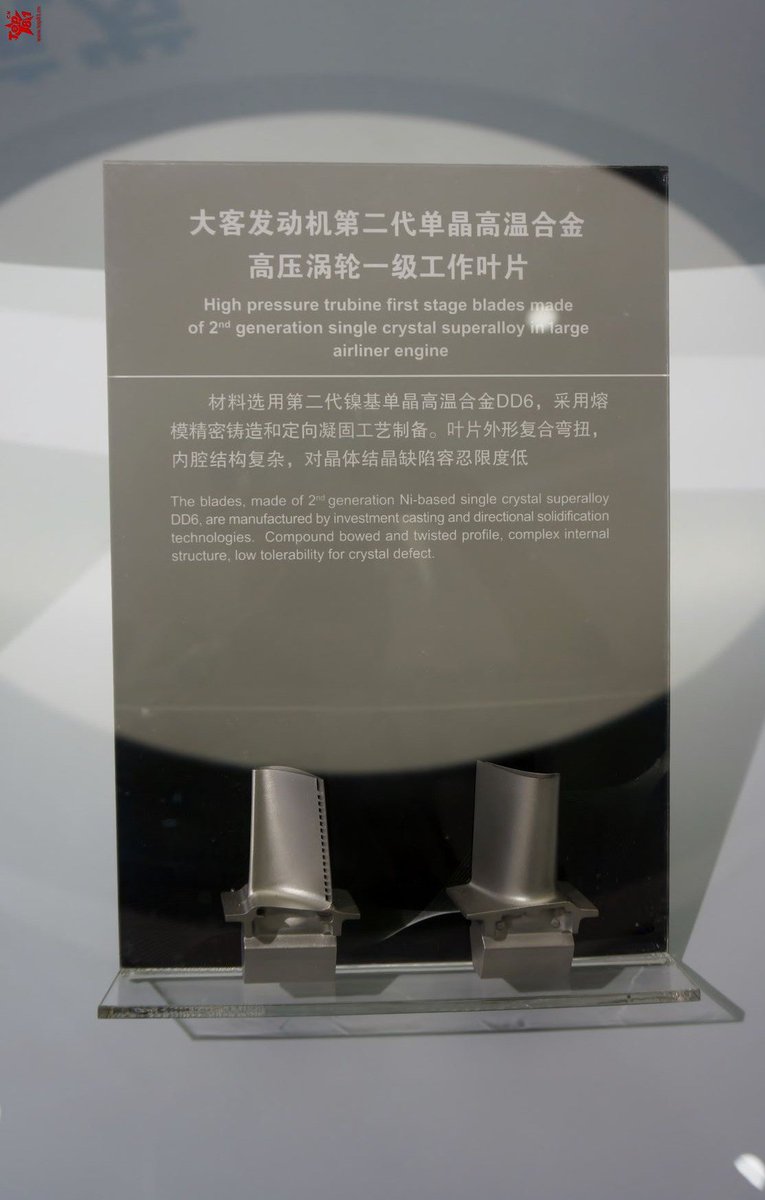Remember this guy from earlier post apparetnly it won a technical award and start serial production and not just for "show". They use lower than 3% Rhenium which can now produced in China Look like they used it on improved WS10B. It takes them 20 years to developed this blade.See the cooling hole in the trailing edge. So it must the first stage turbine blade. China now has even better turbine blade on pipe line DD9 as Kurutoga pic show.
Courtesy of Vincent
——记《第二代单晶高温合金DD6及其航空发动机涡轮叶片研制与应用》项目团队
第3259期 20180130
本报通讯员 刘媛媛
1月8日,2017年度国家科学技术奖励大会在北京人民大会堂隆重举行。由中国航发航材院主承担,中国航发涡轮院、动研所、动力所参研的《第二代单晶高温合金DD6及其航空发动机涡轮叶片研制与应用》项目荣获2017年度国家技术发明奖二等奖,中国航发航材院副总师李嘉荣及团队成员受到党和国家领导人的接见。这是整个团队至高无上的荣誉。
20世纪90年代中期,我国高性能航空发动机涡轮叶片急需高性能材料。对新材料研究的情有独钟以及在清华大学攻读博士学位的学习经历,使李嘉荣敏锐洞察到专业发展的广阔前景。他和团队成员默默许下诺言,一定要把第二代单晶高温合金及其航空发动机涡轮叶片研制出来,以满足我国装备的急需。从此,在漫长而艰辛的探索之路上,这个对祖国许下的庄严承诺始终像一颗明亮的启明星指引他们不畏险阻,坚定前行。
单晶涡轮叶片被誉为“皇冠上的明珠”,工作条件极为苛刻,是决定发动机性能、可靠性与寿命的关键因素,是衡量一个国家整体制造水平的重要标志。而第二代单晶高温合金成分设计受到高温强度、疲劳性能、工艺性能等几十个指标的互相制约,且叶片具有复合弯扭空心薄壁的复杂结构,技术难度极高,欧美大国优先发展,高度垄断,严密封锁。因此,自主创新是发展第二代单晶高温合金及其涡轮叶片的唯一途径。
李嘉荣所在的航材院是一个具有60多个材料相关专业、学科齐全的研究单位,一流的创新资源、创新环境和创新文化所构成的创新生态系统,为打造“科学家的摇篮,工程师的沃土”提供了有力保证。
勇于创新成就新一代单晶高温合金
金属元素“铼”资源稀少,价格昂贵,可显著提升单晶高温合金的高温强度,恰好满足第二代单晶高温合金优异承温能力的要求。欧美通常添加3%的铼元素来发展第二代单晶高温合金,如果与欧美的做法一样,将带来高昂的成本,这对20世纪90年代的研发投入而言是难以接受的。因此,发展低成本的第二代单晶高温合金成为摆在团队面前的重大课题。
李嘉荣与唐定中、刘世忠等成员以无畏的勇气、科学的创新精神集智攻关,成为第一个“吃螃蟹的人”。探索之路一向伴随着尝试与失败,挫折多了,有人开始怀疑技术方案,有人建议仿制欧美合金,有人因为难度大、收入低而离开。而作为带头人的李嘉荣却坚定而自信,他说:“欧美能做出3%铼的二代单晶,我们也能搞出低铼的二代单晶。”李嘉荣带领团队经过几年的艰辛尝试、反复实践,一丝不苟、精益求精,发明了具有完全自主知识产权的高性能低成本第二代单晶高温合金DD6,其性能优于或达到欧美大量应用的第二代单晶高温合金,铼含量降低1/3、成本低20%以上,实现了我国单晶涡轮叶片材料从第一代到第二代的跨越。
严谨的工作简单的幸福
单晶高温合金制备就像“炒菜”,但与“炒菜”靠感觉不同,制备单晶高温合金讲究的是如何科学精准调控10余种主要合金元素,差一点都有可能无法实现30多个相互制约的指标要求。这就要求团队做事严谨,脚踏实地,追求毫厘不差。李嘉荣就是这样一个追求完美、细致入微的人,他具有高度责任感,总是跟团队成员说:“一个先进的航空发动机有两万多个零件,一个细节出现问题,就可能引起重大事故。”他的这种态度无时无刻不在影响着整个团队。
20年前加入团队的韩梅,对于合金熔炼过程记忆犹新。据她介绍,因为担心元素配比丝毫偏差带来误导,他们就在熔炼前仔细将每炉添加的所有原料反复称量,确保精准无误。寒冬腊月的夜晚,李嘉荣带着他们一起穿着军大衣,站在旁边看着每份“调料”加进真空感应熔炼炉,内心充满着对合金成功出炉的期待。直到现在,每当他回想起那个场景都仍觉得很幸福。共同奋斗的“战友情”,成为团队抵御寒冬的丝丝温暖与战胜困难的强大力量。
“对症下药”建立再结晶控制技术体系
2005年,当团队成员信心满满地将单晶空心涡轮叶片拿到工厂机械加工时,却出现了再结晶缺陷,一时难以完全杜绝这种现象,质疑声四起。团队里有的年轻科研人员感到十分困惑:“上百道工序,问题到底出在哪儿啊?”与此同时,整个团队还承受着交付的巨大压力。
越在艰难的时候,李嘉荣越会给大家打气。凭借扎实的理论功底与丰富的工作经验,他对DD6合金充满信心。再结晶是金属材料的一种普遍现象,不是DD6合金所特有的,但需要团队应用金属学理论,科学创建再结晶控制方法。其实,李嘉荣也不是“铁人”,他何尝没有感到“压力山大”和疲惫呢?作为团队领军人,他是团队的精神支柱,不敢、也不能在大家面前表现出一丝动摇。如果说在这20年中,“动摇”二字曾在他脑海中闪现过的话,也只如流星般的转瞬即逝。他出现在大家面前时,仍然是那个“只为成功想办法,不为失败找理由”的带头人。李嘉荣总是忘我工作,经常忙到深夜,20年前满头黑发的他,已变成了头发稀疏的人。
在与李嘉荣共同奋斗20多年的同事刘世忠心中,李嘉荣就是他们的“主心骨”。在最艰难的时候,李嘉荣的鼓励总是如一缕春风,带给大家温暖与希望,“过了这关,就胜利在望了,你们大胆去干,出了问题我负责。”这铿锵有力的话语给了年轻同事们一颗“定心丸”。李嘉荣先后培养了10余名博士、博士后,并指导骆宇时、赵金乾、熊继春等深入钻研再结晶控制方法。在他的带领下,团队中每个科研人员不仅是理论专家,也是实践巧匠。
当团队所有成员相互支撑、共同面对沟坎时,就像一辆所向披靡的坦克勇往直前。经过多年的艰苦攻关、集智创新,团队建立了再结晶控制技术体系,获得6项授权发明专利,为我国单晶涡轮叶片从简单实心到复合弯扭空心跨越的实现提供了重要保障。现在,如果出现再结晶,就能按照这套控制体系开出良方,“对症下药”,保证“药到病除”。
习近平总书记在十九大报告中指出,“要瞄准世界科技前沿,强化基础研究,实现前瞻性基础研究、引领性原创成果重大突破。”李嘉荣正是以敏锐的专业眼光,比肩国际领先水平,带领团队勇于创新、善于创新,攻克了我国高性能航空发动机DD6单晶涡轮叶片研制与应用关键技术,填补国内空白,获17项授权发明专利,发表150余篇学术论文,创建了我国第二代单晶高温合金及其涡轮叶片应用技术体系。DD6单晶涡轮叶片已在我国多型先进航空发动机获得广泛应用,解决了我国先进航空发动机关键材料的迫切急需,实现了我国重大关键军工材料的自主保障。
谈到获奖时,李嘉荣言语间充满了感恩:“感谢时代,二十年艰辛,做成这件事,十分值得,能看到装备着我们研制的单晶涡轮叶片的飞机在祖国的蓝天上翱翔,就是对我们最大的褒奖,我们也践行了对祖国的庄严承诺。”
Google translation
"the second generation of single crystal superalloy DD6 and its aero-engine turbine blades development and application" project team No. 3259 20180130 newspaper correspondent Liu Yuanyuan January 8, 2017
Annual national science and technology awards conference grand ceremony in Beijing's Great Hall was held.
The project of "Development and Application of Second Generation Single Crystal Superalloy DD6 and Its Turbine Blade for Aero-Engine Turbine", researched and put into trial by China Academy of Aeronautics and Astronautics, won the title of "2017 National Technology Invention Award Second Prize,
Li Jiarong, deputy general manager of China Aviation Navigation Material Institute, and team members were interviewed by the party and state leaders. This is the supreme honor of the entire team. The mid-90s of 20th century, China's high-performance aero-engine turbine blades in urgent need of high-performance materials. His delightful interest in new material research and his PhD study experience at Tsinghua University have given Li Jiarong a keen insight into the broad prospects of professional development.
He and his team members promised silently, we must develop the second generation of single crystal superalloy and its aero-engine turbine blades to meet the urgent needs of our equipment. Since then, on a long and arduous journey of exploration, this solemn promise to the motherland has always been like a bright star guiding them unswervingly and resolutely.
Monocrystalline turbine blades known as the "crown jewel", the working conditions are extremely harsh, It determined the engine performance, reliability and life-span and is the the key factors that measure of the overall manufacturing level therfore an important symbol. The design of the second generation single crystal superalloy is constrained by dozens of parameter such as high temperature strength, fatigue performance and process performance, and the composite structure has the complex bending and torsion hollow thin wall structure, and the technical difficulty is extremely high. The major powers in Europe and the United States give priority to development Highly monopolized and tightly sealed.
Therefore, independent innovation is the only way to develop the second generation of single crystal superalloy and its turbine blades. Li Jiarong
A new generation of single crystal superalloy metal element "rhenium" scarced resources, expensive, can significantly enhance the high temperature strength of single crystal superalloy, just to meet the second generation of single crystal superalloy excellent temperature tolerance requirements. Europe and the United States usually add 3% rhenium element to develop the second generation of single crystal superalloy,
If we follow with Europe and the United States, it will result in higher cost, which is unacceptable for R & D investment in the 1990s. Therefore, the development of low-cost second-generation single crystal superalloy has become a major issue in front of the team. Li Jia Rong and Tang Dingzhong and Liu Shizhong became the first "people who eat crabs" with courage and scientific innovation.
Exploration has always been accompanied by failures, setbacks, some people began to doubt the technical solutions, some people suggested that the imitation of European and American practise, Some people because of the difficulty, low income and left. As a leader, Li Jialong is firm and confident. He said: "Europe and the United States can make the second generation single crystal with 3% rhenium, and we can also make the second generation single crystal with low rhenium." Li Jiarong led the team after years of hardships Attempt, repeated practice, meticulous, excellence, invented with completely independent intellectual property rights of high-performance low-cost second-generation single crystal superalloy DD6, its performance is better than or reached parity with the Europe and the United States turbine blade
Bla bla
Then the conclusion
DD6 single crystal turbine blades have been widely used in China's multi-type advanced aeroengines, which has solved the urgent urgent need of the key materials of advanced aeroengines in our country and realized the independent protection of the major key military materials in our country.
When it comes to winning, Li Jiarong is full of thanksgiving words: "Thanks to the era, twenty years of hardships, made it very worthwhile, we can now see the aircraft equipped with the single crystal turbine blades we developed soaring in the blue sky of the motherland That is our greatest compliment, and we have practiced the solemn promise to our motherland. "
Post script DD9



